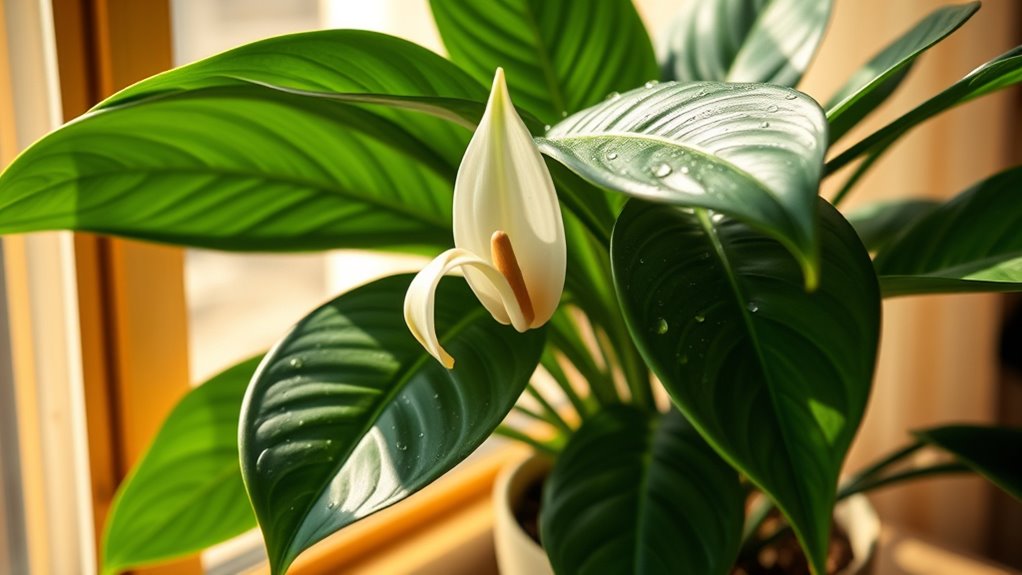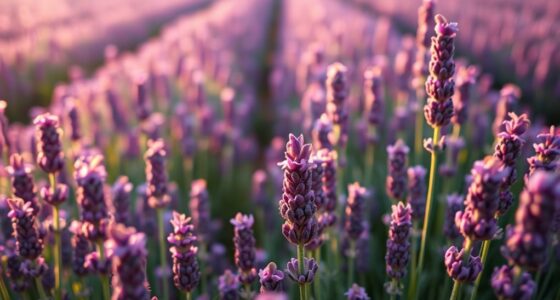To keep your peace lily happy, place it near east-facing windows or provide bright, indirect light, and supplement with artificial lights if needed. Water it when the topsoil feels dry, maintaining consistent moisture without overwatering, and boost humidity by misting or using a gravel tray. Fertilize monthly during active growth with a balanced, diluted fertilizer, and prune faded blooms regularly. For more tips on thriving peace lilies, explore expert advice to guarantee your plant stays healthy and vibrant.
Key Takeaways
- Place near east-facing windows with bright, indirect light; supplement with grow lights in low-light conditions.
- Water with lukewarm, evenly moist soil; avoid overwatering and ensure proper drainage.
- Fertilize monthly with diluted balanced fertilizer during active growth; reduce feeding during winter dormancy.
- Regularly deadhead faded flowers and prune old or damaged foliage to promote new growth.
- Maintain high humidity, stable temperature, and clean environment for vibrant foliage and continuous blooming.
Choosing the Perfect Spot for Your Peace Lily
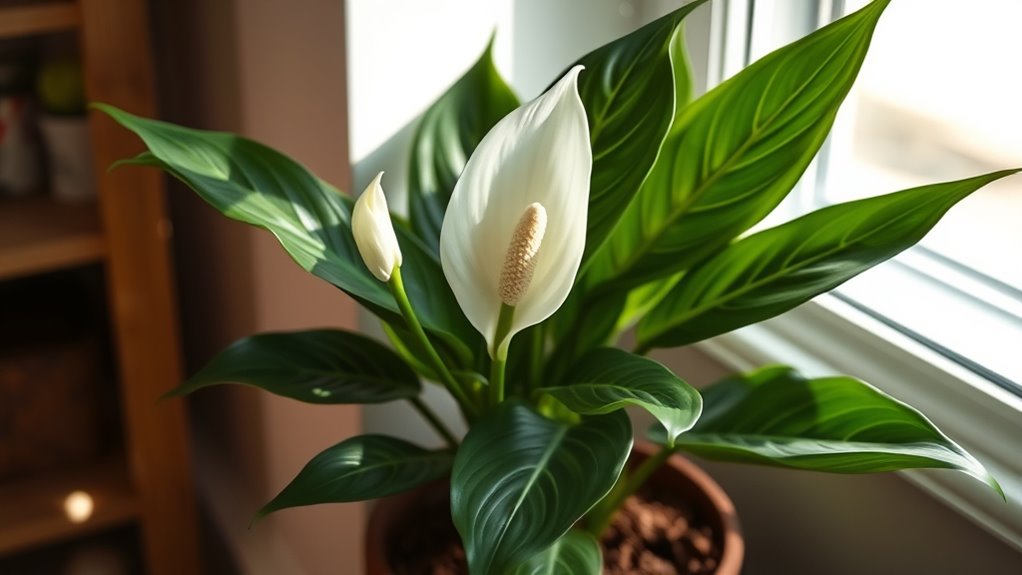
To choose the perfect spot for your Peace Lily, start by placing it near east-facing windows, which offer the partial shade it prefers in its natural habitat. The best type of location provides consistent, indirect sunlight, helping the plant thrive and flower. Make sure to avoid cold drafts and cold windows during winter, as these can harm the plant. To maintain ideal humidity, increase moisture by misting or wiping leaves with a damp cloth. Keep the environment stable; if the air is too dry, the plant may start to dry out before watering. When watering, wait until the roots are completely dry, then water thoroughly but gently. Fertilize once a month with a liquid fertilizer to support healthy growth, and cut back on watering once the soil dries out. Additionally, using a self watering plant pot can help maintain consistent moisture levels and reduce the frequency of watering, contributing to a healthier Peace Lily. Incorporating proper humidity control techniques can further enhance the plant’s overall health and flowering potential. Ensuring adequate humidity levels is essential for optimal growth and vibrant blooms. Proper humidity and consistent care are essential for healthy plant growth, especially in indoor environments.
Optimal Watering and Humidity Tips
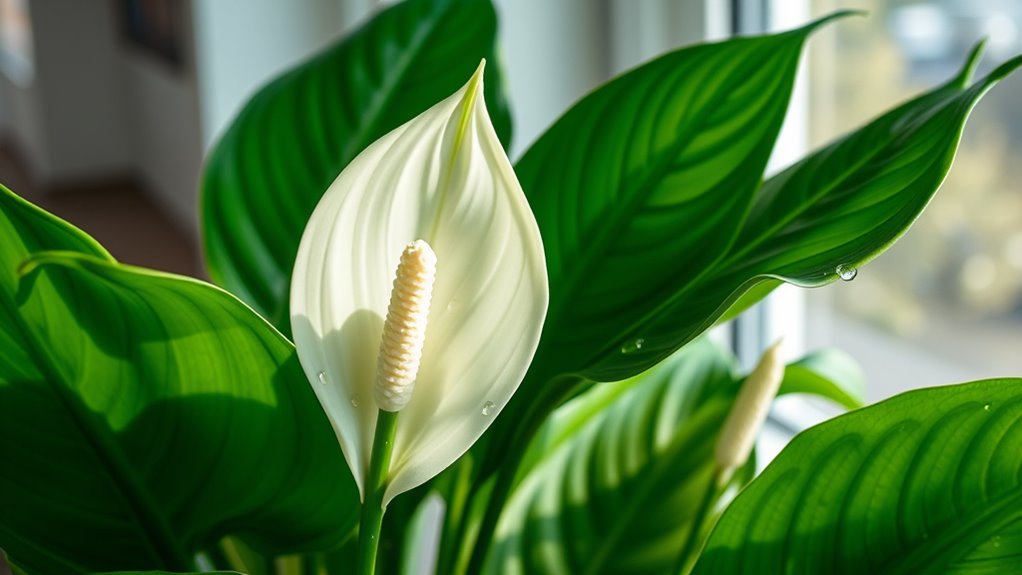
Ensuring your Peace Lily receives proper watering and humidity is essential for its health and vibrant appearance. Water your plant with lukewarm, evenly moist soil, and let it dry out completely between waterings to prevent overwatering and root rot. Proper watering techniques and attentive care during watering routines can significantly enhance the plant’s overall wellbeing. During the growing season, maintain a consistent watering schedule, adjusting based on the plant’s moisture cues and indoor humidity levels. To boost humidity, mist the leaves regularly or place the pot on a moist gravel tray, especially in dry environments. Avoid letting the plant sit in standing water, and always ensure proper drainage to prevent excess moisture from harming the roots. Increasing humidity promotes healthier growth and more frequent flowering, keeping your Peace Lily lush and thriving. Additionally, understanding data privacy concerns related to smart gardening devices can help you make informed choices about technological integrations. Incorporating indoor humidity strategies can help mimic natural conditions and support the plant’s development. Regularly monitoring environmental conditions can further optimize your Peace Lily’s thriving environment, especially as AI-powered sensors become more accessible for home gardening.
Proper Lighting Conditions for Flourishing Growth
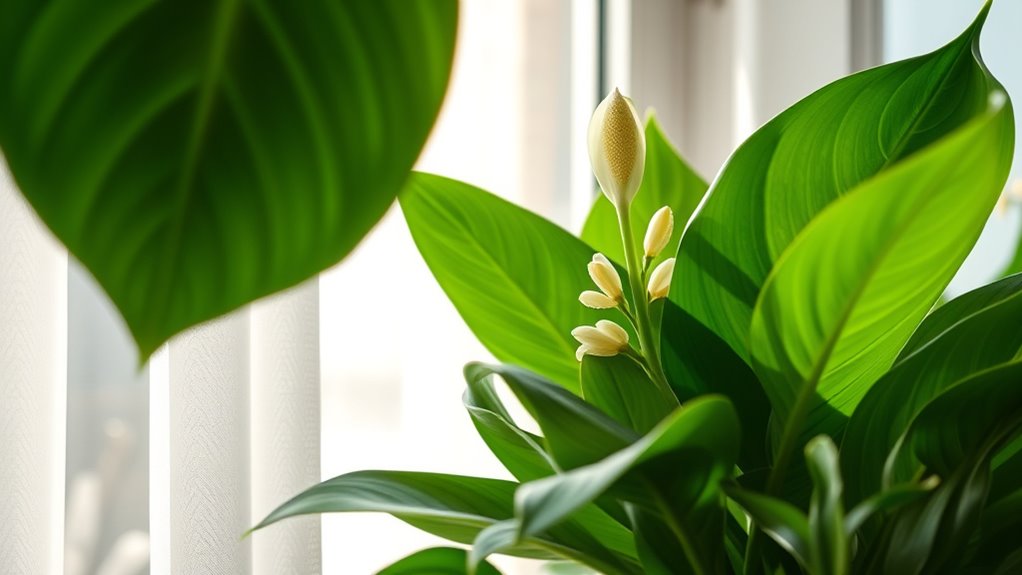
To help your Peace Lily thrive, place it near east-facing windows or in bright, indirect light. Keep it away from direct sunlight, which can scorch the leaves, and avoid deep shade that slows growth. If natural light is limited, consider using artificial grow lights to support healthy flowering and leaf development. Proper lighting conditions are essential for maintaining your plant’s health and vibrant appearance. Additionally, choosing sustainable materials for your planters can contribute to eco-friendly gardening practices. Ensuring the right light spectrum can further enhance the plant’s overall growth and flowering potential. Proper lighting not only influences growth but also impacts plant health, ensuring your Peace Lily remains lush and vigorous.
Ideal Light Placement
Placing your Peace Lily near east-facing windows provides the ideal environment with bright, indirect sunlight that encourages healthy growth and blooming. This position offers gentle morning light, which is perfect for the plant’s needs.
To optimize your Peace Lily’s light placement, consider these points:
- Ensure it receives consistent, indirect sunlight without exposure to harsh midday rays.
- Avoid direct sunlight, especially during peak hours, to prevent leaf scorch.
- If natural light is limited, use fluorescent or grow lights for 12-14 hours daily to supplement.
- During winter, move the plant closer to windows to compensate for shorter daylight hours.
- Proper light placement is crucial for maintaining color accuracy and overall health. Additionally, understanding lighting conditions helps in creating a stable environment that promotes vibrant foliage and flowering.
- Monitoring the light intensity can help you adjust the plant’s position as seasons change, ensuring it continues to thrive.
- Maintaining consistent lighting conditions also supports the plant’s natural growth cycle, which is essential for optimal health and flowering.
Avoid Direct Sunlight
Positioning your Peace Lily near east-facing windows helps provide the gentle, indirect light it prefers. This placement ensures it receives consistent, soft sunlight without exposure to harsh rays that can scorch its glossy leaves. Incorporating cozy textiles like sheer curtains can further diffuse sunlight and protect your plant from direct exposure. Direct sunlight can cause leaves to fade, develop brown scorch marks, or even die back. The white flowers may also bleach or fail to bloom if exposed to intense sun. To protect your plant, use sheer curtains or place it in a shaded spot during the brightest parts of the day. Maintaining these gentle light conditions promotes healthy growth and encourages abundant flowering. Remember, Peace Lilies thrive best in partial shade, so avoiding direct sunlight is key to keeping your plant vibrant and happy.
Fertilizing and Soil Maintenance Practices

To keep your Peace Lily thriving, it’s crucial to choose the right fertilizer and maintain proper soil conditions. Using a balanced liquid fertilizer at half strength once a month during the growing season helps provide necessary nutrients. Annual repotting refreshes the soil and supports healthy roots. Watch for signs of nutrient deficiencies, such as yellowing leaves or poor flowering, and adjust your fertilizing practices accordingly. Incorporating soil health practices can further enhance plant growth and resilience, especially since proper soil management is essential for maintaining optimal plant growth conditions. Regularly assessing your plant’s needs can help prevent trust issues that may arise from neglecting proper care.
Optimal Fertilizer Types
What’s the best way to guarantee your peace lily gets the right nutrients? Using the proper fertilizer types is key. First, choose a balanced, water-soluble houseplant fertilizer and dilute it to half strength. Apply it once a month during spring and summer to support active growth.
Second, incorporate a slow-release granular fertilizer at the start of the growing season for steady nourishment over several months.
Third, always follow the manufacturer’s recommended dosage to prevent over-fertilizing, which can cause leaf tip burn or fewer blooms.
Fourth, during winter dormancy, reduce or stop fertilizing to avoid nutrient buildup that stresses the plant. Proper soil aeration and soil maintenance practices can also enhance nutrient absorption and overall plant health.
Ensuring well-draining, organic-rich soil will help your peace lily absorb these nutrients effectively and stay healthy year-round.
Soil Refreshment Techniques
Maintaining healthy soil is essential for your peace lily’s overall vitality, especially as you incorporate fertilizers to boost growth. During the active growing season, fertilize your plant monthly with a balanced liquid fertilizer diluted to half strength. This provides essential nutrients without risking overfeeding.
Each spring, repot your peace lily using fresh, well-draining compost to replenish nutrients and prevent soil compaction. When repotting, gently loosen the roots and prune any circling or damaged ones to encourage healthy growth.
Be careful not to overwater, as excess moisture can leach nutrients from the soil, so keep it moist but not soggy. Regularly top up or replace the soil to maintain nutrient levels and prevent salt buildup from fertilizers, ensuring your plant’s continued health.
Nutrient Deficiency Signs
Nutrient deficiencies in your peace lily often reveal themselves through noticeable signs like yellowing leaves, stunted growth, or a lack of vibrant blooms despite proper watering. Recognizing these signs helps you identify what your plant needs.
- Pale or yellowing leaves indicate a nitrogen deficiency, affecting overall leaf color and essential vitality.
- Brown, curling leaf edges suggest a potassium shortage, weakening leaf structure.
- Poor flowering or no blooms can signal an imbalance of nutrients, especially phosphorus.
- Excessive salt buildup from over-fertilizing may cause leaf tip burn and leaf margins to brown.
To prevent deficiencies, use a balanced liquid fertilizer during the growing season, follow recommended application rates, and periodically flush the soil to avoid salt buildup. Proper nutrition keeps your peace lily healthy and thriving.
Repotting and Refreshing Your Plant’s Environment
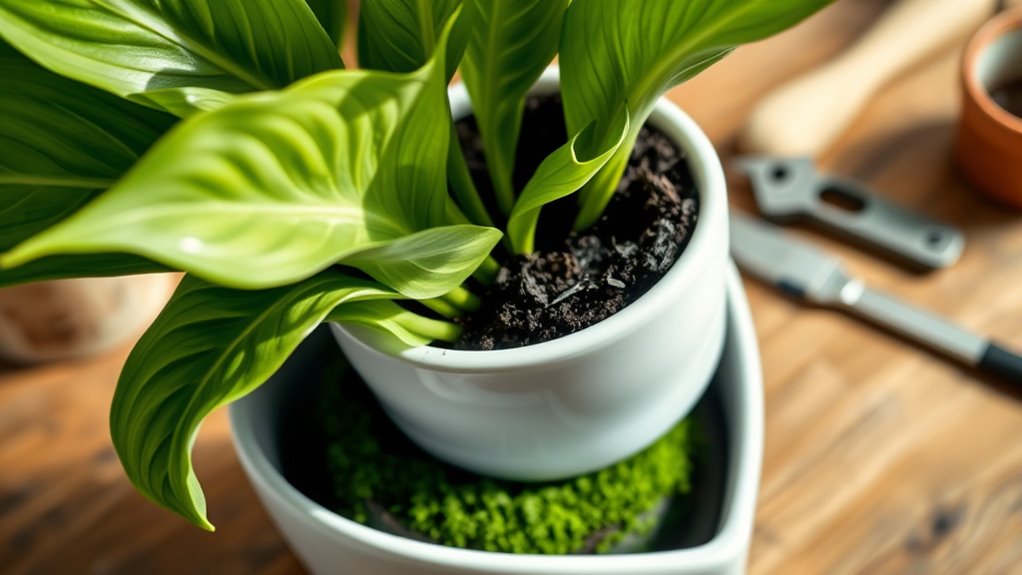
To guarantee your Peace Lily continues to thrive, it’s important to repot it annually in spring once its roots have filled the current container. Choose a slightly larger pot with drainage holes and fill it with well-draining, multi-purpose houseplant compost to provide fresh nutrients and prevent waterlogging.
Before planting, gently loosen the root ball to encourage root expansion. Carefully place the plant into the new pot, ensuring it sits at the same depth as before.
Additionally, refresh the plant’s environment by cleaning the pot and surrounding area. This helps reduce pests and keeps your Peace Lily healthy.
Regular repotting and environment refreshment promote vigorous growth, better nutrient absorption, and overall plant robustness.
Deadheading and Encouraging Continuous Blooms

Ever wonder how to keep your Peace Lily flowering beautifully for longer? Deadheading faded white flowers is key. It signals the plant to produce new blooms and extends its flowering period.
To do this, use clean, sharp scissors or pruning shears to carefully cut the spent flowers at the base of the stem. Regular deadheading prevents the plant from wasting energy on seed production and helps it stay healthy.
Plus, removing old flowers improves its appearance and stimulates new flowering stems. When combined with proper fertilization, deadheading encourages your Peace Lily to bloom continuously throughout the growing season.
Keep these practices in mind to maximize your plant’s beauty and health.
Safety Precautions and Keeping Your Plant Healthy
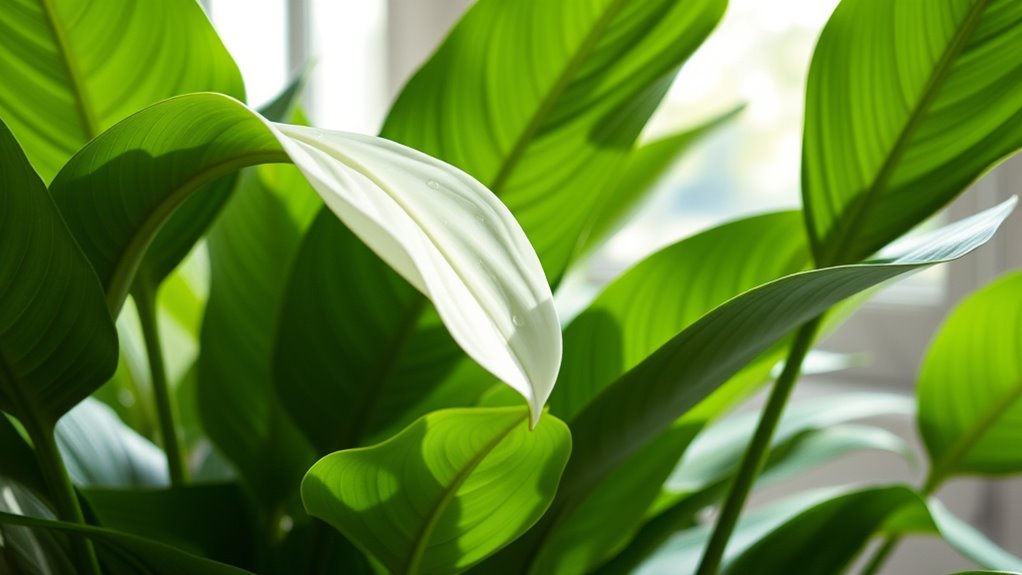
Keeping your Peace Lily healthy and safe requires paying attention to its environment and handling. Keep it out of reach of children and pets, since all parts are toxic if ingested and can cause stomach or respiratory irritation.
Regularly wipe the leaves with a damp cloth to remove dust and prevent pests that could harm the plant’s health. Avoid overwatering, as excess moisture can lead to root rot and other issues.
Place the plant near east-facing windows or in bright, indirect light to support healthy growth and flowering. Monitor environmental conditions to keep temperatures above 21°C and prevent cold drafts, which can stress the plant.
Frequently Asked Questions
How Do I Make My Peace Lily Happy?
To make your Peace Lily happy, give it bright, indirect light near east-facing windows.
Keep the soil consistently moist but not soggy, watering only when the top inch feels dry.
Mist the leaves regularly or use a humid tray to boost humidity.
Fertilize monthly during the growing season, deadhead faded flowers, and repot annually in spring.
These steps promote healthy growth and vibrant blooms, ensuring your plant thrives.
How Do You Keep a Peace Lily Alive Indoors?
To keep a peace lily alive indoors, you need to provide it with bright, indirect light, like near east-facing windows.
Water only when the top inch of soil feels dry, using lukewarm water.
Keep humidity high by misting or using a moist gravel tray.
Fertilize monthly during the growing season, and regularly clean the leaves and deadhead flowers to promote health and blooming.
Should I Cut the Brown Tips off My Peace Lily?
You should cut the brown tips off your Peace Lily to improve its appearance and prevent further damage. Trimming with clean, sharp scissors just removes the brown areas without harming healthy tissue.
This simple step can boost your plant’s look and health. Remember, avoid cutting into green leaf parts, and regularly mist or water with distilled or rainwater to reduce future brown tips.
Your plant will thank you!
Where Is the Best Place to Put a Peace Lily?
You’re wondering where to place your Peace Lily. To keep it happy, position it near east-facing windows for gentle, partial shade that mimics its natural environment.
Keep it away from cold drafts and windows during winter, and avoid direct sunlight that can scorch leaves.
Place it in a well-ventilated spot with stable temperatures above 21°C, ensuring it gets consistent, indirect light to promote healthy growth and flowering.
Conclusion
By following these care tips, you’ll nurture your peace lily into a thriving, green oasis. Think of it as tending a gentle symphony, where every note—water, light, and love—harmonizes to create beauty. With patience and attention, your plant will flourish, bringing serenity and elegance to your space. Remember, a well-cared-for peace lily is more than just a plant—it’s a living testament to your dedication and green thumb.
